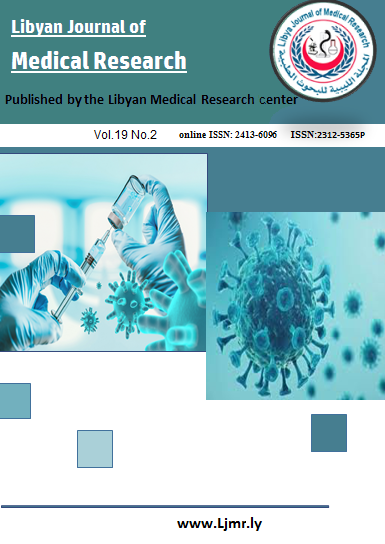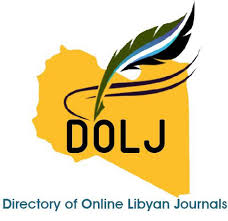The Predictive Value of Fibrosis-4 Score Index for Cirrhosis-Related Complications in a Libyan Patient Cohort
DOI:
https://doi.org/10.54361/LJMR.19.2.39Keywords:
Fibrosis-4 index score, platelet count, cirrhosis complications, non-invasive fibrosis scoreAbstract
Background: Liver cirrhosis is the end stage of chronic liver disease, and it's considered a major cause of morbidity and mortality. Early detection of complications such as esophageal varices is critical for improving outcomes. There are non-invasive markers that can reduce the need for unnecessary invasive procedures. The Fibrosis-4 Index (FIB-4) has shown promise in assessing liver fibrosis and predicting the risk of varices and other complications. Objectives: This study aims to investigate the utility of the Fibrosis-4 Index score as a predictor for the presence of complications (current or past) in patients with established liver cirrhosis. Methods: A cross-sectional, observational study was conducted at the outpatient hepatology clinics of Benghazi Medical Center. A convenience sample of adult patients (aged 18 years and above) with an established diagnosis of liver cirrhosis was consecutively included in the study. The Fibrosis-4 (FIB-4) Index score was calculated for each patient. Results: The study included a total of 101 patients (48 (47.5%) males and 53 (52.5%) females), with liver cirrhosis. The FIB-4 Index score was evaluated in three categories: <1.45, 1.45–3.25, and >3.25. A statistically significant association was found between a FIB-4 Index score >3.25 and the overall frequency of complications (Pearson Chi-square = 7.509, p = 0.006). Conclusions: The study findings add to the existing evidence supporting the clinical utility of the FIB-4 index score (and platelet count ) as a non-invasive marker of the presence of cirrhosis complications. It's particularly reliable in predicting the presence ( cut-off value of 3.25) or absence of complications during the evaluation of liver cirrhosis patients, depending on the score value. Further work-up (e.g. endoscopy) can be restricted to patients with a high risk of having complications, thus avoiding unnecessary tests and reducing the costs.
Downloads
References
1. Kumar S, Kumar V, Giri R, Agarwal S, Gautam SK. Prediction of esophageal varices and risk of bleeding in liver cirrhosis by aspartate aminotransferase to-platelet ratio index and fibrosis-4 index. Int J Adv Med. 2023 Apr 26;10(5):382–7.
2. Sepanlou SG, Safiri S, Bisignano C, Ikuta KS, Merat S, Saberifiroozi M, et al. The global, regional, and national burden of cirrhosis by cause in 195 countries and territories, 1990–2017: a systematic analysis for the Global Burden of Disease Study 2017. Lancet Gastroenterol Hepatol. 2020 Mar;5(3):245–66.
3. Gotlieb N, Schwartz N, Zelber-Sagi S, Chodick G, Shalev V, Shibolet O. Longitudinal decrease in platelet counts as a surrogate marker of liver fibrosis. World J Gastroenterol. 2020 Oct 14;26(38):5849–62.
4. Kraja B, Mone I, Akshija I, Koçollari A, Prifti S, Burazeri G. Predictors of esophageal varices and first variceal bleeding in liver cirrhosis patients. World J Gastroenterol. 2017 Jul 14;23(26):4806–14.
5. Cifci S, Ekmen N. Evaluation of Non-invasive Fibrosis Markers in Predicting Esophageal Variceal Bleeding. Clin Endosc. 2021 Nov 30;54(6):857–63.
6. Yu JH, Lee HA, Kim SU. Noninvasive imaging biomarkers for liver fibrosis in nonalcoholic fatty liver disease: current and future. Clin Mol Hepatol. 2023 Feb 28;29(Suppl):S136–49.
7. Hagström H, Talbäck M, Andreasson A, Walldius G, Hammar N. Repeated FIB-4 measurements can help identify individuals at risk of severe liver disease. J Hepatol. 2020 Nov;73(5):1023–9.
8. Mózes FE, Lee JA, Selvaraj EA, Jayaswal ANA, Trauner M, Boursier J, et al. Diagnostic accuracy of non-invasive tests for advanced fibrosis in patients with NAFLD: an individual patient data meta-analysis. Gut. 2022 May;71(5):1006–19.
9. Ishida K, Namisaki T, Murata K, Fujimoto Y, Takeda S, Enomoto M, et al. Accuracy of Fibrosis-4 Index in Identification of Patients with Cirrhosis Who Could Potentially Avoid Variceal Screening Endoscopy. J Clin Med. 2020 Oct 29;9(11):3510.
10. Blanco-Grau A, Gabriel-Medina P, Rodriguez-Algarra F, Villena Y, Lopez-Martínez R, Augustín S, et al. Assessing Liver Fibrosis Using the FIB4 Index in the Community Setting. Diagnostics. 2021 Nov 29;11(12):2236.
11. Han JW, Kim HY, Yu JH, Kim MN, Chon YE, An JH, et al. Diagnostic accuracy of the Fibrosis-4 index for advanced liver fibrosis in nonalcoholic fatty liver disease with type 2 diabetes: A systematic review and meta-analysis. Clin Mol Hepatol. 2024 Sep 30;30(Suppl):S147–58.
12. Li X, Xu H, Gao P. Fibrosis Index Based on 4 Factors (FIB-4) Predicts Liver Cirrhosis and Hepatocellular Carcinoma in Chronic Hepatitis C Virus (HCV) Patients. Med Sci Monit. 2019 Sep 27;25:7243–50.
13. Sterling RK, Lissen E, Clumeck N, Sola R, Correa MC, Montaner J, et al. Development of a simple noninvasive index to predict significant fibrosis in patients with HIV/HCV coinfection†‡. Hepatology. 2006 Jun;43(6):1317–25.
14. Johnson AL, Hayward KL, Patel P, Horsfall LU, Cheah AEZ, Irvine KM, et al. Predicting Liver‐Related Outcomes in People With Nonalcoholic Fatty Liver Disease: The Prognostic Value of Noninvasive Fibrosis Tests. Hepatol Commun. 2022 Apr;6(4):728–39.
15. 15. Wang HW, Peng CY, Lai HC, Su WP, Lin CH, Chuang PH, et al. New noninvasive index for predicting liver fibrosis in Asian patients with chronic viral hepatitis. Sci Rep. 2017 Jun 12;7(1):3259.
16. 16. Xu X lan, Jiang L shun, Wu C si, Pan L ya, Lou Z qi, Peng C ting, et al. The role of fibrosis index FIB-4 in predicting liver fibrosis stage and clinical prognosis: A diagnostic or screening tool? J Formos Med Assoc. 2022 Feb;121(2):454–66.
17. Wang L, Feng Y, Ma X, Wang G, Wu H, Xie X, et al. Diagnostic efficacy of noninvasive liver fibrosis indexes in predicting portal hypertension in patients with cirrhosis. Yu ML, editor. PLOS ONE. 2017 Aug 18;12(8):e0182969.
18. Zijlstra MK, Gampa A, Joseph N, Sonnenberg A, Fimmel CJ. Progressive changes in platelet counts and Fib-4 scores precede the diagnosis of advanced fibrosis in NASH patients. World J Hepatol. 2023 Feb 27;15(2):225–36.
19. Younes R, Caviglia GP, Govaere O, Rosso C, Armandi A, Sanavia T, et al. Long-term outcomes and predictive ability of non-invasive scoring systems in patients with non-alcoholic fatty liver disease. J Hepatol. 2021 Oct;75(4):786–94.
20. Are VS, Vuppalanchi R, Vilar-Gomez E, Chalasani N. Enhanced Liver Fibrosis Score Can Be Used to Predict Liver-Related Events in Patients With Nonalcoholic Steatohepatitis and Compensated Cirrhosis. Clin Gastroenterol Hepatol. 2021 Jun;19(6):1292-1293.e3.
21. Vieira Barbosa J, Milligan S, Frick A, Broestl J, Younossi Z, Afdhal NH, et al. Fibrosis‐4 Index as an Independent Predictor of Mortality and Liver‐Related Outcomes in NAFLD. Hepatol Commun. 2022 Apr;6(4):765–79.
22. Maev IV, Kuznetsova EI, Andreev DN, Dicheva DT. Diagnostic accuracy of predictive indexes of liver fibrosis in patients with chronic hepatitis C. Ter Arkh. 2020 Feb 27;92(2):24–8.
23. Liu X, Li H, Wei L, Tang Q, Hu P. Optimized cutoffs of gamma‐glutamyl transpeptidase‐to‐platelet ratio, aspartate aminotransferase‐to‐platelet ratio index, and fibrosis‐4 scoring systems for exclusion of cirrhosis in patients with chronic hepatitis B. Hepatol Commun. 2022 Jul;6(7):1664–72.
24. Xiao G, Yang J, Yan L. Comparison of diagnostic accuracy of aspartate aminotransferase to platelet ratio index and fibrosis‐4 index for detecting liver fibrosis in adult patients with chronic hepatitis B virus infection: A systemic review and meta‐analysis. Hepatology. 2015 Jan;61(1):292–302.
25. Cheng CH, Chu CY, Chen HL, Lin IT, Wu CH, Lee YK, et al. Subgroup analysis of the predictive ability of aspartate aminotransferase to platelet ratio index (APRI) and fibrosis-4 (FIB-4) for assessing hepatic fibrosis among patients with chronic hepatitis C. J Microbiol Immunol Infect. 2020 Aug;53(4):542–9.
26. Li Y, Chen Y, Zhao Y. The Diagnostic Value of the FIB-4 Index for Staging Hepatitis B-Related Fibrosis: A Meta-Analysis. Schmidt RLane, editor. PLoS ONE. 2014 Aug 28;9(8):e105728.
Downloads
Published
Issue
Section
License
Copyright (c) 2025 Abdelhakim M. Elbarsha, Sahar H.Summad, Mabrouka M.Alshokri, Sami A. Lawgaly, Mussa G. Tuwati (Author)

This work is licensed under a Creative Commons Attribution-NonCommercial-NoDerivatives 4.0 International License.
Open Access Policy
Libyan journal of medical Research (LJMR).is an open journal, therefore there are no fees required for downloading any publication from the journal website by authors, readers, and institution.
The journal applies the license of CC BY (a Creative Commons Attribution 4.0 International license). This license allows authors to keep ownership f the copyright of their papers. But this license permits any user to download , print out, extract, reuse, archive, and distribute the article, so long as appropriate credit is given to the authors and the source of the work.
The license ensures that the article will be available as widely as possible and that the article can be included in any scientific archive.
Editorial Policy
The publication of an article in a peer reviewed journal is an essential model for Libyan journal of medical Research (LJMR). It is necessary to agree upon standards of expected ethical behavior for all parties involved in the act of publishing: the author, the journal editorial, the peer reviewer and the publisher.
Any manuscript or substantial parts of it, submitted to the journal must not be under consideration by any other journal. In general, the manuscript should not have already been published in any journal or other citable form, although it may have been deposited on a preprint server. Authors are required to ensure that no material submitted as part of a manuscript infringes existing copyrights, or the rights of a third party.
Authorship Policy
The manuscript authorship should be limited to those who have made a significant contribution and intellectual input to the research submitted to the journal, including design, performance, interpretation of the reported study, and writing the manuscript. All those who have made significant contributions should be listed as co-authors.
Others who have participated in certain substantive aspects of the manuscript but without intellectual input should only be recognized in the acknowledgements section of the manuscript. Also, one of the authors should be selected as the corresponding author to communicate with the journal and approve the final version of the manuscript for publication in the LJMR.
Peer-review Policy
- All the manuscripts submitted to LJMR will be subjected to the double-blinded peer-review process;
- The manuscript will be reviewed by two suitable experts in the respective subject area.
- Reports of all the reviewers will be considered while deciding on acceptance/revision or rejection of a manuscript.
- Editor-In-Chief will make the final decision, based on the reviewer’s comments.
- Editor-In-Chief can ask one or more advisory board members for their suggestions upon a manuscript, before making the final decision.
- Associate editor and review editors provide administrative support to maintain the integrity of the peer-review process.
- In case, authors challenge the editor’s negative decision with suitable arguments, the manuscript can be sent to one more reviewer and the final decision will be made based upon his recommendations.














